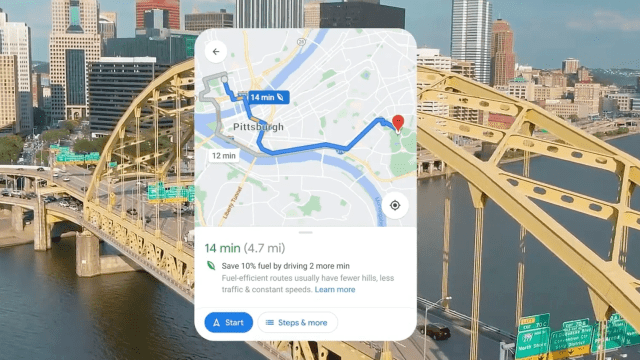If you’re a regular Google Maps user, you might be able to use the app to make less emissions-intensive choices in the future. Google announced on Wednesday that it is adding options to show drivers less carbon-intensive routes on the Maps app, along with a slew of other individual-focused tools like showing the carbon footprint of flights.
The new feature is available in the U.S. now and will become an option in Europe next year. The service is powered by Google’s own AI and data from the Department of Energy’s National Renewable Energy Laboratory. Google said that it estimates the feature could avoid more than 1 million tons of carbon emissions per year, or the equivalent of taking 200,000 cars from the road. (Google didn’t provide any information as to how they arrived at this calculation, or how many Google users would have to consistently use the feature to get those savings.)
The fastest route in a car is not always the most carbon-efficient. Things like stop-and-go traffic and the smoothness of your driving can also affect emissions. Studies have also shown that most cars have a speed “sweet spot” when it comes to efficiency. Driving below 56 kph and above 105 kph tend to result in more emissions. Google said its data will also take into account things like road types, inclines, and congestion to help with its calculations.
“This benefits the planet and also helps drivers save money, as routes that require higher fuel consumption also lead to higher gas bills,” Russell Dicker, director of transportation product at Google Maps, told the Wall Street Journal in April, when the company first announced the initiative.
The announcement comes in combination with what Google says will be better cycling navigation as well as more information on bikeshares in different cities. This is part of a suite of sustainability initiatives Google says it’s rolling out today, including initiatives meant to help folks find less carbon-intensive flights, see hotels’ sustainability commitments and eco certifications, and work with their Nest thermostat to support renewable energy and energy efficiency.
Technically, this feature is supposed to be live today, but we couldn’t… use it. The company’s so-called “eco-friendly routes” are denoted by a green leaf and language about how much more fuel-efficient a route is. I tried plugging in lots of different routes (route from my apartment to various spots in New York, from my parents’ house to spots in my hometown, from my college in Maine to day trips around the state), and I didn’t see anything different about the app on my phone. Ditto for my browser. Earther managing editor Brian Kahn tried and also failed to get an “eco-friendly” route. There’s a chance that the handful of routes we picked at random simply happened to be the most efficient and the fastest, but Brian tried out the route featured in the image in Google’s blog post and got nada, so maybe the UX update just hasn’t reached us yet. We’ve reached out to Google to get some help testing the feature and will update this post if we get a chance to test this out.
Even without the ability to test out Google Maps’ new feature, I still have a lot of questions about the utility of this service. It appears that the option for less carbon-intensive routes may only appear if the routes are of comparable speed to the fastest route, which would suggest that Maps might not show you a slower route that would be less emissions-intense if it’s past some sort of speed cutoff. Google also emphasised that this feature is entirely opt-in and is easy to shut off in settings, so it’s very easy to ignore if you want.
All of Google’s announcements today — the hotels, the flights, the Maps redesigns, the options for using Nest — may be helpful, but they’re still firmly on the side of “individuals can fix this whole climate thing,” which ain’t it, chief. Google has touted its work to decarbonize its data centres by 2030, but it’s worth remembering that the company has a lot to answer beyond its own carbon footprint, from the way that YouTube has helped promote climate denial to the fact that Google works with oil and gas companies to provide cloud services that help extract more oil and gas. My ability to find a slightly more carbon-efficient drive home can’t exactly offset all that.
